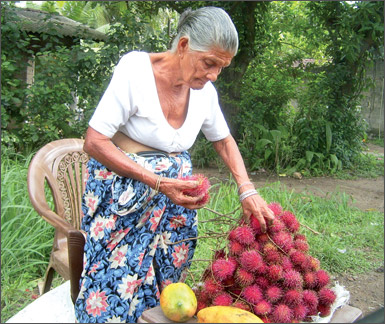Presenting Apekama in tourism
Vipula Wanigasekera
A recent visitor who arrived on a business tour said something that
is food for thought. In his words 'Every time I land in any airport, all
I see is a concrete jungle but here, it is beautiful greenery that I
witnessed in the surrounding until the plane hit the ground'. Thousands
of tourists who are arriving in Sri Lanka for the first time, may be
experiencing this.
Some countries are very particular when presenting their traditional
dance forms to foreign audiences. Often, after the welcome drink, the
delegates are ushered into an auditorium where the cultural show is
presented and then they are taken to mingle at cocktails.

Tourists in the Incentive Travel category can be induced to sell
‘Rambuttan’ fruits during the season |
The reason being to get the undisturbed attention of the audience to
different dance forms which they may have not seen elsewhere. In other
words, to give them an experience of witnessing something unique. For
instance the traditional Kandyan Ves and Southern Thelme are exclusive
to Sri Lanka and nowhere else can the steps and variations be found in
any other dance forms in the world.
To emphasize the point further, a British CEO of a multinational and
his wife refused to be taken to mega malls in Colombo and instead they
were insisting on shopping in Pettah along the pavements encircled by
the colonial structures which they had read about. They loved the walk
through the muddy and congested road ways, bargaining with the vendors
and the few things bought to be taken back.
Just the other day, at the breakfast buffet of a hill country hotel
had Karapincha kenda and when the guests were educated that curry leaves
had the substance to bring down cholesterol, they promptly had the
second round of Kenda with the breakfast .
The idea that emerged from the visitors was why the authentic health
benefits were not briefly written on the description of local food
offered for the benefit of the foreigners.
The potential of visitors to Ramayana sites is not looked at from the
view point of pilgrim tourism. It truly lies in the emotional and
devotional appeal that will make the visits memorable.
Today the Ramayana tours are reaching a gradual success mainly
because of the opportunities given to the devotees to experience 'the
devotion' than the comforts or relaxation or even visiting the sites.
In a fierce competition to attract tourists and gain a reasonable
market share, marketeers come up with various tactics and gimmicks in
addition to overall branding and positioning of a destination in the
minds of potential travellers.
However, often they get carried away with what the successful
destinations offer which more or less submerge the real strengths of a
country that one might call Apekama.
There is no argument that the basics that the visitors look for
should be made available such as facilities and comforts depending on
their budgets. How would then a destination like Sri Lanka differentiate
herself when the direct competitors offer similar attractions from
beaches to mountains? This is where the Apekama can be embedded into the
programs with a positive approach to ensure that the visitors gain 'new
experience'.
There was a time when some quarters lamented over the English
knowledge when the biggest tourism markets for Sri Lanka were Germany
and France. If at all, the emphasis should have been on German and
French.
The emerging markets viz China, Russia, and Japan do not call for
service in the English language either. The Chairman of the Hotel School
quite rightly said in his speech to the passing out graduates, 'Do not
worry too much about grammatical errors of English, just speak and they
will understand.'
Sri Lanka is truly a wonder not only because of the known attractions
but also the 'undiscovered traditions and life styles' yet to be
presented to the visitors during their holidays.
Research has revealed that more 'experiential holidays' are sought
after as against the traditional relaxation that was the key customer
requirement in the 70s and 80s.
Several destination management companies in Sri Lanka have succeeded
in developing creative programs and they have got the visitors to pluck
tea, sell vegetables, live a day with villagers, join the work in paddy
fields, learn traditional dance steps, help prepare Sri Lankan cuisine
etc.
These have been categorised as 'Incentive Travel' but the marketeers
need to think beyond and see how best Apekama can be incorporated into
programs thus offering an 'experiential' holiday to the visitors which
they have hitherto undiscovered. |



